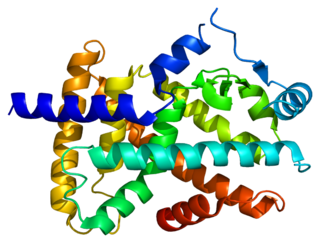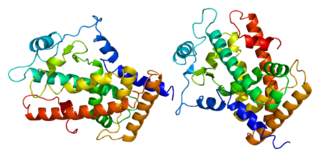
The thiazolidinediones, abbreviated as TZD, also known as glitazones after the prototypical drug ciglitazone, are a class of heterocyclic compounds consisting of a five-membered C3NS ring. The term usually refers to a family of drugs used in the treatment of diabetes mellitus type 2 that were introduced in the late 1990s.

In the field of molecular biology, the peroxisome proliferator–activated receptors (PPARs) are a group of nuclear receptor proteins that function as transcription factors regulating the expression of genes. PPARs play essential roles in the regulation of cellular differentiation, development, and metabolism, and tumorigenesis of higher organisms.

Telmisartan, sold under the brand name Micardis among others, is a medication used to treat high blood pressure, heart failure, and diabetic kidney disease. It is a reasonable initial treatment for high blood pressure. It is taken by mouth. Versions are available as the combination telmisartan/hydrochlorothiazide, telmisartan/cilnidipine and telmisartan/amlodipine.

Peroxisome proliferator-activated receptor gamma, also known as the glitazone reverse insulin resistance receptor, or NR1C3 is a type II nuclear receptor functioning as a transcription factor that in humans is encoded by the PPARG gene.

Peroxisome proliferator-activated receptor alpha (PPAR-α), also known as NR1C1, is a nuclear receptor protein functioning as a transcription factor that in humans is encoded by the PPARA gene. Together with peroxisome proliferator-activated receptor delta and peroxisome proliferator-activated receptor gamma, PPAR-alpha is part of the subfamily of peroxisome proliferator-activated receptors. It was the first member of the PPAR family to be cloned in 1990 by Stephen Green and has been identified as the nuclear receptor for a diverse class of rodent hepatocarcinogens that causes proliferation of peroxisomes.

Liver X receptor alpha (LXR-alpha) is a nuclear receptor protein that in humans is encoded by the NR1H3 gene.

Peroxisome proliferator-activated receptor delta(PPAR-delta), or (PPAR-beta), also known as Nuclear hormone receptor 1(NUC1) is a nuclear receptor that in humans is encoded by the PPARD gene.

Free fatty acid receptor 1 (FFAR1), also known as G-protein coupled receptor 40 (GPR40), is a rhodopsin-like G-protein coupled receptor that is coded by the FFAR1 gene. This gene is located on the short arm of chromosome 19 at position 13.12. G protein-coupled receptors reside on their parent cells' surface membranes, bind any one of the specific set of ligands that they recognize, and thereby are activated to trigger certain responses in their parent cells. FFAR1 is a member of a small family of structurally and functionally related GPRs termed free fatty acid receptors (FFARs). This family includes at least three other FFARs viz., FFAR2, FFAR3, and FFAR4. FFARs bind and thereby are activated by certain fatty acids.

Muraglitazar is a dual peroxisome proliferator-activated receptor agonist with affinity to PPARα and PPARγ.

Tesaglitazar is a dual peroxisome proliferator-activated receptor agonist with affinity to PPARα and PPARγ, proposed for the management of type 2 diabetes.

GW501516 is a PPARδ receptor agonist that was invented in a collaboration between Ligand Pharmaceuticals and GlaxoSmithKline in the 1990s. It entered into clinical development as a drug candidate for metabolic and cardiovascular diseases, but was abandoned in 2007 because animal testing showed that the drug caused cancer to develop rapidly in several organs.

PPAR agonists are drugs which act upon the peroxisome proliferator-activated receptor. They are used for the treatment of symptoms of the metabolic syndrome, mainly for lowering triglycerides and blood sugar.
Glucagon-like peptide-1 (GLP-1) receptor agonists, also known as GLP-1 analogs, GLP-1DAs or incretin mimetics, are a class of drugs that reduce blood sugar and energy intake by activating the GLP-1 receptor. They mimic the actions of the endogenous incretin hormone GLP-1 that is released by the gut after eating.
Palmitoylethanolamide (PEA) is an endogenous fatty acid amide, and lipid modulator PEA has been studied in in vitro and in vivo systems using exogenously added or dosed compound; there is evidence that it binds to a nuclear receptor, through which it exerts a variety of biological effects, some related to chronic inflammation and pain.

Darglitazone is a member of the thiazolidinedione class of drugs and an agonist of peroxisome proliferator-activated receptor-γ (PPAR-γ), an orphan member of the nuclear receptor superfamily of transcription factors. It has a variety of insulin-sensitizing effects, such as improving glycemic and lipidemic control, and was researched by Pfizer as a treatment of metabolic disorders such as type 2 diabetes mellitus.
Tetradecylthioacetic acid (TTA) is a synthetic fatty acid used as a nutritional supplement.

GW0742 is a PPARδ/β agonist that has been investigated for drug use by GlaxoSmithKline.

Seladelpar is a PPARδ receptor agonist that is being investigated for drug use by Metabolex. According to a press release they are examining its potential use for the treatment of dyslipidemia, metabolic syndrome, type 2 diabetes, and non-alcoholic steatohepatitis (NASH). The compound was licensed from Janssen Pharmaceutica NV. The drug completed a phase II trial for primary biliary cholangitis. "Seladelpar demonstrated robust, dose-dependent, clinically significant, and durable improvements in biochemical markers of cholestasis and inflammation in patients with PBC at risk of disease progression. Seladelpar appeared safe and well tolerated and was not associated with any increase in pruritus." A phase III trial in patients with PBC also found reduced pruritus and improved liver biochemistry, despite being terminated early.

Saroglitazar is a drug for the treatment of type 2 diabetes mellitus and dyslipidemia. It is approved for use in India by the Drug Controller General of India. Saroglitazar is indicated for the treatment of diabetic dyslipidemia and hypertriglyceridemia with type 2 diabetes mellitus not controlled by statin therapy. In clinical studies, saroglitazar has demonstrated reduction of triglycerides (TG), LDL cholesterol, VLDL cholesterol, non-HDL cholesterol and an increase in HDL cholesterol a characteristic hallmark of atherogenic diabetic dyslipidemia (ADD). It has also shown anti-diabetic medication properties by reducing the fasting plasma glucose and HBA1c in diabetes patients.
Lobeglitazone is an antidiabetic drug in the thiazolidinedione class of drugs. As an agonist for both PPARα and PPARγ, it works as an insulin sensitizer by binding to the PPAR receptors in fat cells and making the cells more responsive to insulin.















